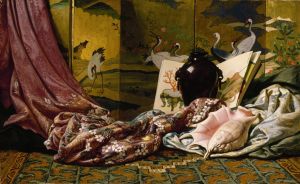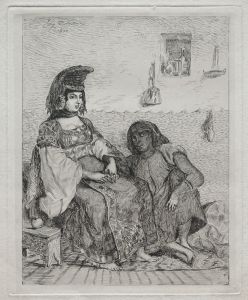
Selim and Zuleika
A hand-painted replica of Eugène Delacroix’s masterpiece Selim and Zuleika, meticulously crafted by professional artists to capture the true essence of the original. Each piece is created with museum-quality canvas and rare mineral pigments, carefully painted by experienced artists with delicate brushstrokes and rich, layered colors to perfectly recreate the texture of the original artwork. Unlike machine-printed reproductions, this hand-painted version brings the painting to life, infused with the artist’s emotions and skill in every stroke. Whether for personal collection or home decoration, it instantly elevates the artistic atmosphere of any space.
Eugène Delacroix, a leading figure of the French Romantic movement, painted "Selim and Zuleika" in 1857. This artwork is a vivid representation of Delacroix's fascination with Oriental themes, which was a common interest among Romantic artists of the 19th century. Delacroix's work often drew inspiration from literature, history, and his own travels, and "Selim and Zuleika" is no exception.
The painting is based on the narrative poem "The Bride of Abydos" by Lord Byron, a prominent English Romantic poet. Byron's poem tells the tragic love story of Selim and Zuleika, two young lovers caught in a web of familial duty and forbidden passion. Delacroix, known for his dramatic and expressive style, captures the emotional intensity of Byron's tale through his use of color, composition, and dynamic figures.
In "Selim and Zuleika," Delacroix employs a rich palette to convey the exotic and emotional atmosphere of the scene. The painting is characterized by its vibrant colors and dramatic contrasts, which are hallmarks of Delacroix's style. The figures of Selim and Zuleika are depicted with a sense of movement and tension, reflecting the turmoil of their love story. Delacroix's brushwork is both fluid and precise, allowing him to convey the textures of fabric and the subtleties of human expression.
Delacroix's interest in Orientalism, a term used to describe the Western fascination with Eastern cultures, is evident in this work. His portrayal of the characters and setting reflects a romanticized vision of the East, which was common in European art and literature of the time. Delacroix's travels to North Africa in 1832 had a profound impact on his artistic vision, providing him with firsthand experience of the landscapes, people, and cultures that would inspire many of his works.
"Selim and Zuleika" is an example of Delacroix's ability to blend narrative and emotion with his technical skill. The painting not only illustrates a literary source but also embodies the Romantic ideals of passion, exoticism, and the sublime. Delacroix's work often explored themes of love, violence, and the human condition, and this painting is a testament to his ability to convey complex emotions through art.
The painting is housed in the Musée des Beaux-Arts de Bordeaux, where it continues to be appreciated for its artistic and historical significance. Delacroix's influence on later artists, including the Impressionists and Post-Impressionists, underscores his importance in the history of art. His innovative use of color and expressive brushwork paved the way for future generations of artists to explore new artistic possibilities.
In summary, "Selim and Zuleika" by Eugène Delacroix is a masterful example of Romantic art, capturing the drama and emotion of Byron's poem through Delacroix's distinctive style. The painting reflects the artist's fascination with Oriental themes and his ability to convey powerful narratives through his art.


















